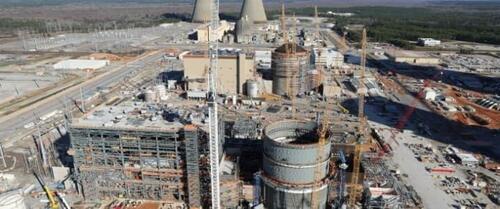
Authored by Leonard Hyman and William Tilles via OilPrice.com,
-
Vogtle 3 and 4 stations are now likely to cost roughly $34 billion.
-
Nuclear power continues to fail to gain commercial respectability in the U.S.
-
The Vogtle plant is up to 10 times more expensive than alternative projects in Europe.
It has not been a good week for advocates of new nuclear power plant construction in the US.
An energy cooperative in Georgia, the Municipal Energy Authority of Georgia (MEAG), announced in a recent filing that the new twin unit Vogtle 3 and 4 nuclear generating stations approaching completion in Waynesboro, Georgia were now likely to cost roughly $34 billion. MEAG, along with other electric co-ops like Oglethorpe Power and Dalton Utilities own minority stakes in the nuclear facility along with majority owner Georgia Power. The two Westinghouse design AP1000 reactors, which are now scheduled to enter commercial service in 2023, were originally estimated to cost $14 billion and enter commercial service in 2016/2017, that is, six years late and 250% over budget. And people wonder why this technology is still struggling for commercial respectability.
As for regulators, the Georgia Public Service Commission (PSC) might sound to some like an extension of Georgia Power’s legal and accounting departments. PSC Commissioner Nichols has extolled the virtues of this wildly expensive plant on two interesting grounds.
-
First, he cited the likelihood of a large carbon tax, which we should point out, most Republicans strongly oppose.
-
And second, he emphasized the so-called “war on fossil fuels”. Sorry but anyone watching oil and gas stock prices lately knows the war on fossil fuels is as real as the war on Christmas.
Bottom line: we would expect the Georgia PSC to disallow a token amount of the egregious cost overruns, the company will respond publicly by lamenting a grievous financial wrong, while its stock and bonds rally strongly.
To us, few words define this AP1000 saga as well as “debacle.” Let's take a look at what was initially promised. Six year construction times, factory built modules to speed up construction, and a commercial service cost of $6,400 per kilowatt. Instead, we see a fourteen-year construction project at an astounding $15,500 per kilowatt. It isn’t even controversial to say this technology is deader than a proverbial doornail in the US. What’s more important is that the small modular reactor business has made many of the same claims (factory built, short construction times, smaller physical footprint), all of which deserve increasing scrutiny.
But the key energy statistic of the week was from Europe where last year they spent about $40 billion to add 26,000 MWs of renewables. In the US we’re spending $34 billion for 2200 MWs. That makes Vogtle ten times as expensive, on a MW basis, as the European alternatives. Even after adjusting for the fact that renewables only produce about one third of the time, compared to 90% of the time for a well-run nuke, Vogtle looks expensive.
As we have said previously, generating electricity from nuclear energy may be a worthwhile societal endeavor (think defense, national energy security, security, research, radioisotopes used in medicine) but it is not even remotely commercial. This means that further nuclear power developments need to proceed as a government-financed or owned enterprises, as they are in most other countries. Otherwise, nuclear power in the US it is likely to go the way of the dodo.
Authored by Leonard Hyman and William Tilles via OilPrice.com,
-
Vogtle 3 and 4 stations are now likely to cost roughly $34 billion.
-
Nuclear power continues to fail to gain commercial respectability in the U.S.
-
The Vogtle plant is up to 10 times more expensive than alternative projects in Europe.
It has not been a good week for advocates of new nuclear power plant construction in the US.
An energy cooperative in Georgia, the Municipal Energy Authority of Georgia (MEAG), announced in a recent filing that the new twin unit Vogtle 3 and 4 nuclear generating stations approaching completion in Waynesboro, Georgia were now likely to cost roughly $34 billion. MEAG, along with other electric co-ops like Oglethorpe Power and Dalton Utilities own minority stakes in the nuclear facility along with majority owner Georgia Power. The two Westinghouse design AP1000 reactors, which are now scheduled to enter commercial service in 2023, were originally estimated to cost $14 billion and enter commercial service in 2016/2017, that is, six years late and 250% over budget. And people wonder why this technology is still struggling for commercial respectability.
As for regulators, the Georgia Public Service Commission (PSC) might sound to some like an extension of Georgia Power’s legal and accounting departments. PSC Commissioner Nichols has extolled the virtues of this wildly expensive plant on two interesting grounds.
-
First, he cited the likelihood of a large carbon tax, which we should point out, most Republicans strongly oppose.
-
And second, he emphasized the so-called “war on fossil fuels”. Sorry but anyone watching oil and gas stock prices lately knows the war on fossil fuels is as real as the war on Christmas.
Bottom line: we would expect the Georgia PSC to disallow a token amount of the egregious cost overruns, the company will respond publicly by lamenting a grievous financial wrong, while its stock and bonds rally strongly.
To us, few words define this AP1000 saga as well as “debacle.” Let’s take a look at what was initially promised. Six year construction times, factory built modules to speed up construction, and a commercial service cost of $6,400 per kilowatt. Instead, we see a fourteen-year construction project at an astounding $15,500 per kilowatt. It isn’t even controversial to say this technology is deader than a proverbial doornail in the US. What’s more important is that the small modular reactor business has made many of the same claims (factory built, short construction times, smaller physical footprint), all of which deserve increasing scrutiny.
But the key energy statistic of the week was from Europe where last year they spent about $40 billion to add 26,000 MWs of renewables. In the US we’re spending $34 billion for 2200 MWs. That makes Vogtle ten times as expensive, on a MW basis, as the European alternatives. Even after adjusting for the fact that renewables only produce about one third of the time, compared to 90% of the time for a well-run nuke, Vogtle looks expensive.
As we have said previously, generating electricity from nuclear energy may be a worthwhile societal endeavor (think defense, national energy security, security, research, radioisotopes used in medicine) but it is not even remotely commercial. This means that further nuclear power developments need to proceed as a government-financed or owned enterprises, as they are in most other countries. Otherwise, nuclear power in the US it is likely to go the way of the dodo.






